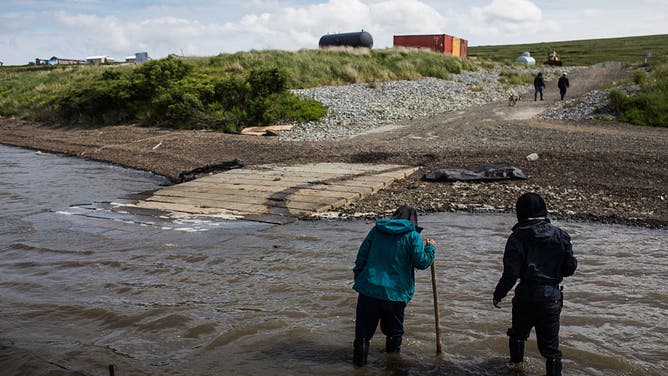Alaska, Washington native villages threatened by climate change receive $75 million to relocate
Under the new Voluntary Community-Driven Relocation program, three tribal communities will each receive $25 million to begin relocating core infrastructure threatened by sea-level rise, flooding and extreme weather.

File photo: Newtok residents check out the future location of the village, which is having to be relocated to Nelson Island on July 2, 2015 near Newtok, Alaska. (Photo by Andrew Burton/Getty Images)
(Getty Images)
Three Native American villages in Alaska and Washington directly impacted by flooding and extreme weather due to climate change were awarded a combined $75 million to begin relocating their communities.
Under the new Voluntary Community-Driven Relocation program announced this week during the 2022 White House Tribal Nations Summit, three tribal communities will each receive $25 million to begin relocating core infrastructure threatened by sea-level rise, flooding and extreme weather.
In all, the Department of Interior-managed program received $115 million for 11 tribes impacted by climate change from the Bipartisan Infrastructure Law and Inflation Reduction Act.
The Newtok Village and Native Village of Napakiak, both in Alaska, and the Quinault Indian Nation in Washington, have been selected to receive $25 million each to begin community-driven relocation. According to the Department of Interior, these three communities will be the proving ground to develop standards for relocation due to climate change.
FEMA has also awarded the three communities $17.7 million to help efforts to acquire, demolish and build new infrastructure away from the impacts of climate change.
Eight other communities in Alaska, Arizona, California, Louisiana and Maine will receive $5 million each to fund planning to decide on the relocation of climate change resilience measures.
Climate change scientists agree the Arctic Circle, which includes parts of Alaska, is a "bellwether for climate change," indicating what is to come for the the rest of the planet.

File photo: The village of Newtok is seen from a plane on June 29, 2015 in Newtok, Alaska. (Photo by Andrew Burton/Getty Images)
"From wildfires out west to typhoons in Alaska, I have seen firsthand the devastating affect climate change and extreme weather has on communities across the nation, especially in Indian Country," FEMA Administrator Deanne Criswell said in a statement.
Newtok Village on the Ninglick River in western Alaska has been experiencing coastal erosion due to storms and permafrost melt. According to recent studies, there is no cost-effective way to stop homes and buildings from being overcome by water or collapse.
"At the current rate of erosion of approximately 70 feet per year, the river is expected to threaten structures within two years and the village’s critical infrastructure within four years," according to the Department of Interior news release.
ALASKA EXPERIENCES AN EARTHQUAKE EVERY 10 MINUTES, SCIENTISTS SAY
The new village location, Mertarvik, is about nine miles across the Ninglick River.
Erosion threatens homes, water supply, airports and the school in the Native Village of Napakiak on the Kuskokwim River.

Schoolchildren walk beside severe erosion of the permafrost tundra next to their school at the climate change affected Yupik Eskimo village of Napakiak on the Yukon Delta in Alaska on April 18, 2019. (Photo credit: MARK RALSTON/AFP via Getty Images)
(Getty Images)
Current estimates put the erosion at 25 to 50 feet yearly, with the most critical infrastructure destroyed by 2030.
The village has been planning to relocate, but funding has delayed the move.
Other communities in Alaska have seen significant structural damage due to recent storms.
In September, storm surge from a former typhoon caused major coastal flooding in Alaska. The storm marked the strongest to hit Alaska in decades.
In the Olympic Peninsula of Washington, the Quinault Indian Nation will relocate its Taholah Village. The community between the Quinault River and the Pacific Ocean faces threats from both sides due to rising sea levels, river flooding and tsunami hazards.
RISING SEA LEVELS TO FLOOD NEARLY 650,000 OCEANFRONT PROPERTIES ACROSS US BY 2050, STUDY FINDS
The Tribe plans to move the village to a higher location, but lack of funding has long-delayed the relocation process.
"Helping these communities move to safety on their homelands is one of the most important climate-related investments we could make in Indian Country," Secretary of the Interior Deb Haaland said.
In December, a three-month planning period will begin with the communities and the federal government establishing a formal plan, including developing budgets and timelines for the moves.